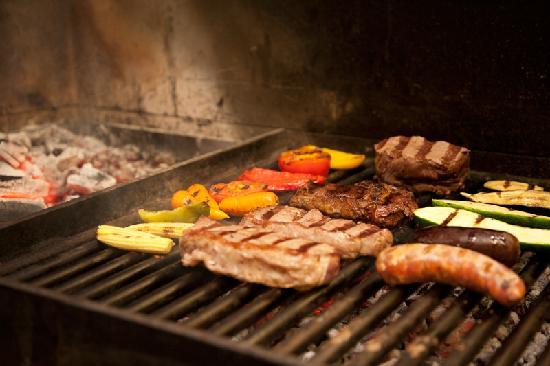Southgate Road, Islington, is the unassuming location for tonight’s cookery masterclass at Argentine restaurant, De La Panza, which literally translates as “all about the belly”. This certainly proved to be true in what turned out to be a typical bovine banquet at a Bodegón (a simple neighbourhood restaurant).
This is billed as the Ultimate Parrillada Masterclass, a celebration of the traditional Argentinian charcoal grill, with former Gaucho Grill and Santa Maria del Sur chef Ernesto Labrada Del Toro, at the helm, whose praises were sung (or should I say yelled) by Gordon Ramsay on Channel 4’s The F-Word.
Ernesto recently started these fortnightly Sunday afternoon masterclasses to reveal the secrets of why Argentinian beef is often considered the best, demonstrate the basic techniques used in grilling and highlight the majesty of the mighty steak in all it’s various guises.
Whilst Ernesto wielded huge slabs of fresh beef and set about trimming and preparing them we learnt that a grass-based diet is what makes Argentinian cattle – comprising Shorthorn, Aberdeen Angus and Hereford – so special. They feast on huge nutrient-dense grassland areas, twice the size of the UK, known as Pampas. The result is fresher tasting meat containing less saturated fat and more Omega-3 – far healthier than the beef from American and European grain/corn-fed cattle.
We learnt about the various cuts including Ancho, Lomo and Picana, or Rib-eye, Fillet and Rump Cap, to you and I. In fact, the latter was of particular interest in that the technique for cooking such a thin strip of meat is to grill one side until 90 per cent cooked. Once the red juices start to flow from the top, it’s a quick pinch of salt and then it’s ready.
I can honestly say, I’ve never enjoyed a piece of rump as much as this. What can often be a laboriously chewy cut of meat was rendered glistening and tender, an absolute joy to eat.
Sat around a table, Argentian Pinot Noir in hand, the class began with Ernesto deftly demonstrating how to butterfly the various cuts of steak, which involved slicing open and laying out thick slabs of beef to aid even cooking.
An ingenious method was used for the Rib-eye whereby it was cut down to the daunting nugget of fat in the middle and unfolded into a long strip, which the Gauchos traditionally refer to as the ‘belt’. This evenly distributes the fat which makes it palatable when grilled and flavours the meat throughout.
We were given a chance to try some of these techniques. An invaluable lesson, however, I politely declined fearing if I got any closer to the meat before it was cooked and served, my anticipation would reach critical levels. Thankfully, what I took to be a collective and gnawing sense of hunger was assuaged when minutas or, not so little, Argentinian nibbles were brought to the table. As the rich, earthy Malbec began to flow, we tucked into whole morcilla, slices of Argentinian chorizo and empanadas, essentially a Gaucho’s miniature Cornish pasty.
After this we were herded, cattle-like, into the kitchen for the highlight of the evening’s demonstration – to witness the charcoal grill in action. Interestingly, very little is done to the meat before cooking commences. The strips of fat are rubbed along the grill in place of oil and act almost like butter that constantly bastes the meat as the heat works its mercurial magic.
The heat, it seems, is key to cooking the perfect steak. The grill should just feel hot and not burn the hand when placed above it. A simple test is to sprinkle some water on the grill and if it sizzles for a few seconds then disappears you have the perfect temperature. If it just disappears, it’s too hot.
Another revelation was to season the beef with salt after it has been placed on the grill and then only on the top side. This is because salt burns in heat, creating flames, which is not welcome unless you want lumps of charcoal above and below the grill. Also, as it cooks the salt sinks down into the meat, gradually flavouring it throughout.
I was surprised by how slow the whole process was. After the initial charring, the beef is moved away from the coals and left for a good 20 minutes. This ensures a more gradual cooking that helps the meat retain heat and flavour but remains a juicy medium-rare.
Most kitchens in Argentina feature a large, primarily wood-fired, grill which commonly uses this method. Peppers, sausages and meat are all cooked like this and served simply with lashings of herby chimichurri. I remarked to Ernesto that the grill is almost used as the main method of flavouring the food as very little else is done to it beforehand. He seemed to agree with this but I suspect was just keen to hurry us out of the kitchen as the time to eat had arrived.
In true Gaucho style, we feasted on never-ending portions of delectable beef, served with perfect, crispy chips and a rather, let’s face it, token salad. The Malbec proved to be a perfect accompaniment to rich beef and the ideal grape for Argentinian soil, despite being of French origin. In place of dessert, thankfully, was a refreshingly chilled, sweet Malbec. A first for me and utterly delicious.
The masterclass, from beginning to end, was an absolute joy. Ernesto’s genuine enthusiasm and love for his craft is both reassuring and totally infectious and £50 per person is incredible value considering the amount of food, wine and knowledge imparted.
It’s also a great social event and I believe they have succeeded in bringing the traditional Bodegón experience to a corner of North London.
Click here for more meaty and barbecue cookery courses in the UK

